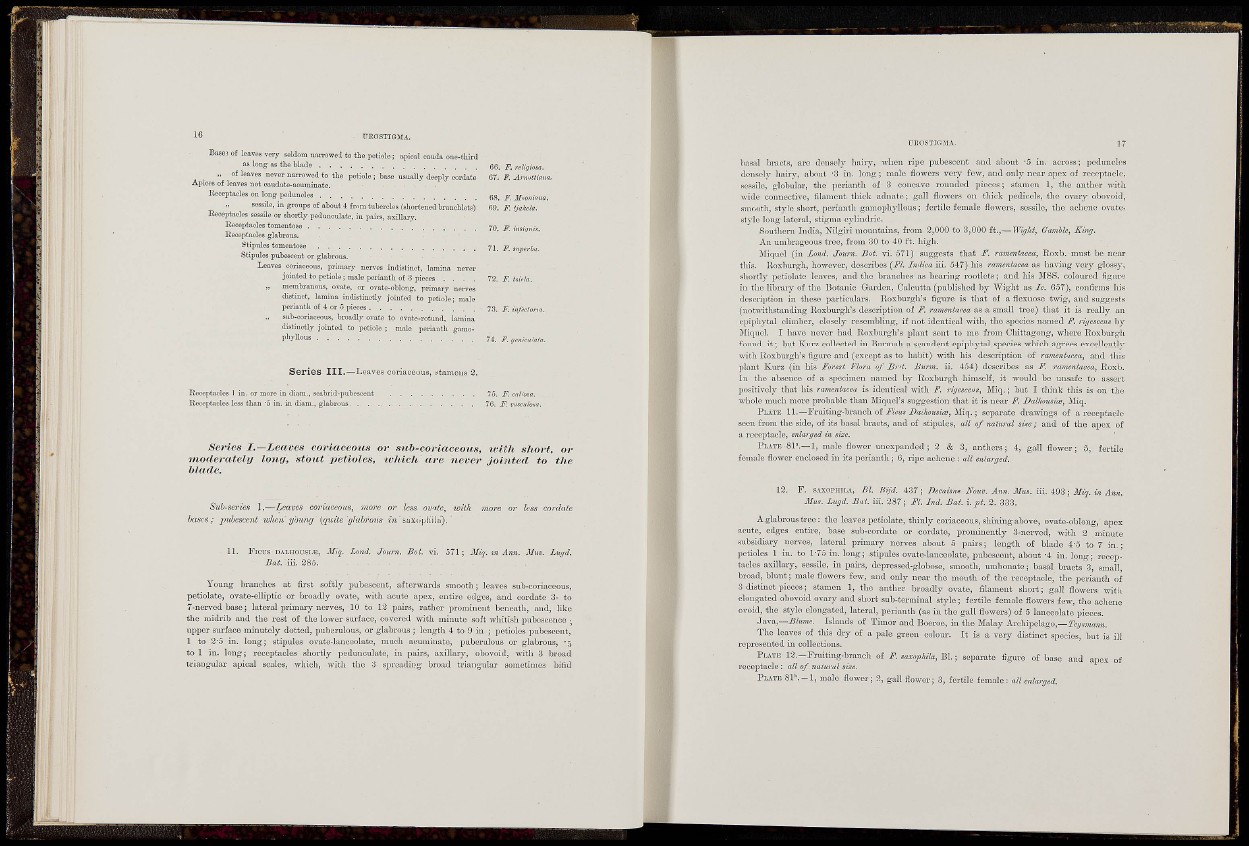
16 T7E0STIGMA.
Bases of leaves very seldom narrowei to the petiole; apical cauda one-third
as long as the blade 66. Jl religiosa.
„ o f leaves never narrowed to the petiole ; hase usually deeply cordate 67. F. ArnoUiona.
Apices of leaves not caudate-acuminate.
a long peduncles 68 Z W-oimna.
essile, in groups of about 4 frnm tubercles (shortened branehlets) «9. F. tjakela.
ir shortly pedunculate, in pairs, axillary.
F. insifpm.
Eeceptacles glabrous.
f i ^ B S tomentosa 71. F. ,upi,-i„.
Stipules pubescent or glabrous.
Leaves coi-iaceous, primary nerves indistinct, lamina never
jointed -to petiole ; male perianth of 3 pieces , , . . 72. F. tdpìa.
„ membranous, ovate, or ovate-oblong, primaiy nerves
distinct, lamina indistinctly Jointed to petiole; male
perianth of 4 or 5 pieces 73. i^. infectona.
„ sub-coriaceous, broadly ovate to ovate-rotimd, lamina
distinctly jointed to petiole ; male perianth gamo-
Pi^yllo'is gcnicuiata.
S e r i e s III.—L e a v e s coriaceous, .-^tameiis 2.
Eeceptacles less than -5 i
Q diam., scabrid-pubescent
in diam., glabrous. . . . .
75. F. callosa.
76. F. vtiseiUoM.
Series I.—Leaves eoriaceous or siih-coriaceotts, ii^lth short, or
inoderatelij long, stoat petioles, tvliich are never jointed to the
blade.
Sub-series ].—Leaves coriaceous, more or less ovie, with more or less cordate
bases; pubescent when y'lning (quite gkibrons m'saxuphihi).'
11. Ficus dalhousi.-!!,
Bai. iii. 285.
Zond. Journ. Boi. vi. 571 ; Miq. in Ann. Mus. Liujd.
Young branches at first softly pubescent, afterwards smooth; leaves sub-coriaceous,
petiolate, oyate-elliptic or broadly ovate, with acute apex, entire edges, and cordate 3- to
7-nerved base; lateral primary nerves, 10 to 12 pairs, rather prominent beneath, and, like
t h e midrib and the rest of the lower surface, covered with minute soft whiti.sh pubescence •
upper surface minutel y dotted, puberulous, or glabrous ; length 4 to 9 in. ; petioles piibcscent,
1 to 2'5 in. long; stipules ovate-lanceolate, much acuminate, puberulous or glabrous, -5
to 1 in. long; receptacles shortly pedunculate, in pairs, axillary, obovoid, witli 3 broad
triangular apical scales, which, with the 3 spreading broad triangular sometimes bifid
basal bracts, are densely haiiy, when ripe pubescent and about -5 in. across; peduncles
densely hairy, about -3 in. long ; male flowers very few, and only near apex of receptficle,
sessile, globular, the perianth of 3 concave rounded pieces; stamen 1, the anther with
wide connective, filament thick adnate; gall flowers on thick pedicels, the ovary obovoid,
smootii, style short, perianth gainophyllous ; fertile femal e flowers, sessile, the achene ovate,
stj-lc long lateral, stigma cylindric.
Soutliern India, Nilgii-i mountains, from 2,000 to 3,000 f t . ,— Wi(/ht, Gamble, King.
An umbrageous tree, from 30 to 40 f t . high.
Miquel (in Lond. Journ. Bot. vi. 571) suggests that F. ramentacca, Roxb. must be near
tliis. Roxburgh, however, describes {Fl. Indica iii. 547) his ramcntaoea as having very glossy,
shortly petiolate leaves, and the branches as bearing rootlets; and his MSS. coloui-ed figiu-ii
in the library of the Botanic Garden, Calcutta (published by "Wight as Ic. 657), confirms his
description in these particulars. Roxburgh's figure is that of a flexuose twig, and suggests
(notwithstanding Roxburgh's description of F. ramentarea as a small tree) that it is really an
epiphytal climber, closely resembling, if not identical with, the species named F. rii/escejis by
Miquel. I have never had Roxburg]\'s plant sent to me from Chittagong, wliere Roxburgli
found it; but Kurz collected in Burmah a scandent epiphytal species which agrees excellently
with Roxburgh's figure and (except as to habit) with his description of ramoni'icea, and tliis
plant Kurz (in his Forest Flora of Br-t. Burm. ii. 454) describes as F. ramcntacea, Roxb.
In the absence of a specimen named by Roxbm-gh himself, it would be unsafe to assert
positive!}'- that his rameniacea is identical with F. rigescens, Jliq. ; but I think this is on the
-n'hole much more probable than Miguel's suggestion that it is near F. DaUmisim, Miq.
P l a t e 11.—Fruiting-branch of J'ì'chs i^ii/Aoasiie, Miq. ; separate di-awings of a receptacle
seen from the side, of its basal bracts, and of stipules, all of natural size; and of the apex of
a receptacle, enlarged in size.
P l a t e 81".—1, male flower unexpanded ; 2 & 3, anthers; 4, gall flower; 5, fertile
female flower enclosed in its perianth ; 6, ripe achene : all enlarged.
12. F. s.\.xopniLA, Bl. Hijd. i'iT Decaisne Nouv. Ann. Mus. iii.'iQZ ] Miq. in Ann.
Mus. Lugd. Bai. iii. 287; FL hid. Bat. i. pi. 2. 333.
A glabrous t r e e : the leaves petiolate, thinly coriaceous, shining above, ovate-oblong, apex
acute, edges entire, base sub-cordate or cordate, prominently 3-nerved, witli 2 minute
subsidiary nerves, lateral primary nerves about 0 paii-s; length of blade 4-o to 7 in. •
petioles 1 in. to 1-75 in. long; stipules ovate-lanceolate, pubescent, about -4 in. long; receptacles
axillary, sessile, in paii-s, depressed-globose, smooth, umbonate; basal bracts 3, small,
broad, blunt; male flowers few, and only near the mouth of the receptacle, the perianth of
3 distinct pieces; stamen 1, the anther broadly ovate, filament short; gall flowers with
elongated obovoid ovary and short sub-terminal style; fertile female flowers few, the achene
ovoid, the style elongated, lateral, perianth (as iu the gall flowers) of 5 lanceolate pieces.
Ja.v&,—Bhme. Islands of Timor and Boeroe, in the Malay Archipelago,—
The leaves of tliis day of a pale green colom-. It is a very distinct species, but is ill
represented in collections.
P l a t e 12.-Fruiting-branch of F. sa3;ophaa, Bl.; separate figure of base and apex of
receptacle: all of naturul size.
PuiTE 81". -1, male flower; 2, gall flower, 3, fertile female: all enlarged.